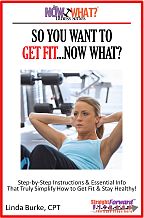Buy "The Now What? eBooks" Here! Or go to Smashwords for misc. formats.
The Now What Fitness Series lays out the foundation of fitness in a concise and simplified manner, making for a collection of books that help the reader truly comprehend how to improve one's health and well-being from A to Z. I've broken fitness down into comprehensive concepts, giving anybody who truly wants to change their health and their lives in profound ways, the step-by-step tools and knowledge to do so.
NUTRITION AND EXERCISE
Nutrition and Exercise is the topic of this page because Straightforwardfitness.com is not about nutrition alone. It's about fitness. Fitness encompasses the combination of both; therefore, we will be discussing Nutrition from the perspective of an exercising individual.
Why does nutrition and exercise have to be so complicated? Questions like these can make you want to pull your hair out:

Should I eat red meat and how often?
Should I eat dairy products and how much?
Should I eat fat and how much?
How many calories should I consume daily?
How much protein do I really need?
Are carbs good, bad, or ugly?
Should I become a vegetarian and grow my own food?
Should I take supplements and if so, what, when, and how much?
All of these questions are good ones. Unfortunately, there is not one good answer. There are many good answers and they are very individually-based. In other words, one answer does not fit all.
If you Google each question, you would come up with hundreds of answers for each one. Hence, the confusion and the controversies concerning nutrition and exercise abound.
In the following paragraphs and pages, I will attempt to simplify these nutrition issues and offer concise facts instead of hype whenever applicable. At the very least, I will point you to links that digress further when concise answers will not suffice.
It is not my intent to add to the confusion about nutrition and exercise by listing the myriad possible answers or solutions, but rather to clarify and de-mythify (no I don’t have a lisp) when and where I can. Ultimately, it is you who must decide what and how much you put in your mouth.

FOOD COMP 101
Nutrients are life-sustaining substances found in food. They supply the body with energy and structural materials; they regulate growth, maintenance, and repair the body’s tissues.
The six major classes of nutrients are: protein, carbohydrates, fat, vitamins, minerals, and water. The amount of each nutrient that a body needs varies widely; however, there are guidelines to ensure that we receive enough nutrients to sustain a healthy and active lifestyle.
The three main nutrients that provide calories or energy are called macronutrients. Proteins, carbs, and fat provide calories. Calories are the fuel that our bodies run on just as a car runs on gasoline.
- One gram of protein has 4 calories.
- One gram of carbohydrate has 4 calories.
- One gram of fat has 9 calories.
How many calories do we need daily? The amount of calories one should consume daily varies from individual to individual according to gender, size, age, activity level, etc. Go to freedieting.com for an excellent free calculation of your daily caloric needs. Actually, freedieting has a whole slew of other calculators on that page that are fun and interesting to play with. It’s way cool, so be sure and check it out. It's excellent sites like these that truly help us understand the key to proper nutrition and exercise.
ACE says...
According to the American Council on Exercise (ACE), normal, healthy adults of average size who engage in physical activity should consume the following amounts of nutrients daily to remain in optimal health.
- Protein—approximately 50 to 70 grams, depending on body size, or 12 to 20% of caloric intake of protein.
- Carbohydrates—a minimum of 125 grams, optimal 250 to 400 grams, or 55% to 65% of caloric intake as carbs.
- Fat—approximately 30 to 65 grams, depending on caloric consumption, or 25% to 30% of caloric intake from fat.
- Vitamins—specific amounts are listed in the Recommended Dietary Allowances (RDA).
- Minerals—specific amounts are listed in the RDA.
- Water—2 to 3 quarts per day.
Well, are you feeling better yet?

Not to panic...let’s take a closer look at them, shall we? Click the links below for more answers:
THINK ABOUT THIS

If you have two obese parents there is an 80% chance you will be obese; with one parent, 40%; and with lean parents you only have a 10% chance. But don’t despair! Since the chances aren’t 100%, it is not written in stone. It just means you will have to work a little harder and be a bit more determined. So let’s go hit the gym and then have one of my monster salads with a big helping of grass-fed chicken breast! It just makes the nutrition and exercise part of the plan that much more important. You can do it! I have faith in you!!
Return from Nutrition and Exercise to Straightforwardfitness Home
